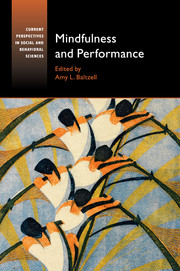Book contents
- Frontmatter
- Dedication
- Epigraph
- Contents
- List of figures
- List of tables
- List of contributors
- Preface
- Acknowledgments
- I INTRODUCTION TO MINDFULNESS: HISTORY AND THEORETICAL UNDERSTANDING
- 1 Mindfulness Scholarship and Interventions: A Review
- 2 Mindfulness, Emotion Regulation, and Performance
- 3 Self-Compassion, Distress Tolerance, and Mindfulness in Performance
- 4 Flow and Mindfulness in Performance
- 5 Peak Performance: Langerian Mindfulness and Flow
- 6 Langerian Mindfulness and Liminal Performing Spaces
- II FORMAL MINDFULNESS INTERVENTIONS IN SPORT
- III MINDFULNESS: THEORY TO PRACTICE IN SPORT AND EXERCISE
- IV MINDFULNESS AND THE PERFORMING ARTS
- V MINDFULNESS FOR COACHES, PRACTITIONERS, AND MENTORS
- VI FUTURE DIRECTIONS
- Index
- References
5 - Peak Performance: Langerian Mindfulness and Flow
from I - INTRODUCTION TO MINDFULNESS: HISTORY AND THEORETICAL UNDERSTANDING
Published online by Cambridge University Press: 05 January 2016
- Frontmatter
- Dedication
- Epigraph
- Contents
- List of figures
- List of tables
- List of contributors
- Preface
- Acknowledgments
- I INTRODUCTION TO MINDFULNESS: HISTORY AND THEORETICAL UNDERSTANDING
- 1 Mindfulness Scholarship and Interventions: A Review
- 2 Mindfulness, Emotion Regulation, and Performance
- 3 Self-Compassion, Distress Tolerance, and Mindfulness in Performance
- 4 Flow and Mindfulness in Performance
- 5 Peak Performance: Langerian Mindfulness and Flow
- 6 Langerian Mindfulness and Liminal Performing Spaces
- II FORMAL MINDFULNESS INTERVENTIONS IN SPORT
- III MINDFULNESS: THEORY TO PRACTICE IN SPORT AND EXERCISE
- IV MINDFULNESS AND THE PERFORMING ARTS
- V MINDFULNESS FOR COACHES, PRACTITIONERS, AND MENTORS
- VI FUTURE DIRECTIONS
- Index
- References
Summary
Performance, including sport performance, appears to transpire in a series of connected and sequentially related moments. The time-oriented context of performance is characterized by the interplay of complex array of behaviors consisting of emotional, cognitive, behavioral, and physiological factors. Some studies have focused on the stress-oriented variables that are embedded within the manifestation of performance configuration (see, for instance, Craft et al., 2003). On the other hand, the analysis of a given performance may suggest that a performance may fall into a low, middle, or high level of excitement. At low levels, performance levels are slow, and at high levels, performance may suffer too since the performance is intensely overwhelmed by the excitement level.
The Yerkes-Dodson Curve (Yerkes & Dudson, 1908) indicates that optimal task performance occurs at the mid-level of excitement or diffuse psychological arousal. In defining a peak performance, scholars have focused on special extraordinary features of a performance, which on the one hand embodies the previously achieved level of competencies and functionality and on the other hand exceeds and supersedes the quality of the past positive experiences in connection with the given task (see Privette 1981, 1983, 1991).
An in-depth exploration of the constituents of a peak performance may highlight the interconnectedness of positive features in the wholeness of a performance, including relaxation, confidence, high energy, present-centered focus, extraordinary awareness, a feeling of being in control, and detachment from distractions (see Cohn, 1991; Garfield & Bennett, 1984). When it comes to sport performance, sport psychology has displayed an interest in exploring the relationship between positive self-talk, emotional regulation, and heightened performance (for instance, see Kornspan, Overby, & Lerner, 2004).
In line with the sport psychology studies, Csikszentmihalyi's (1975, 1979, 1990) conceptualization of flow has inspired the field with continued interest in looking into facilitating factors that can contribute to an enhancement of performance. Flow refers to those experiences in which you become so indulged in an activity that you lose awareness of everything else around you. You feel “in the zone,” and time flies. The activity itself becomes a reward in and of itself. Csikszentmihalyi's model of flow, which was earlier called autotelic experiences, originated from his interviews with many people who experienced a full engagement in their activities, such as rock climbers and chess players.
- Type
- Chapter
- Information
- Mindfulness and Performance , pp. 101 - 111Publisher: Cambridge University PressPrint publication year: 2016
References
- 1
- Cited by



